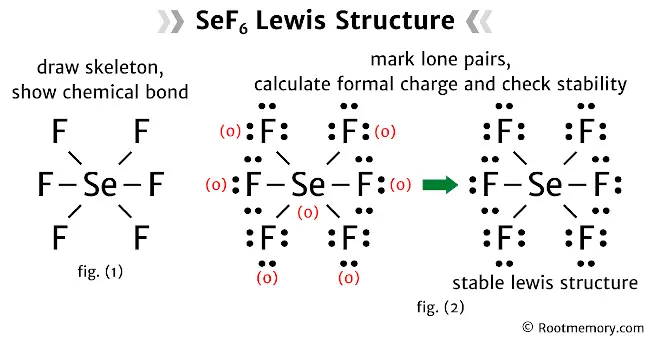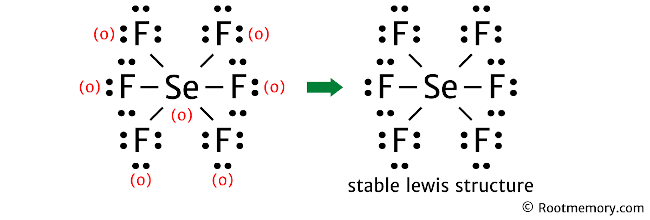
The Lewis structure of SeF6 contains six single bonds, with selenium in the center, and six fluorines on either side. There are three lone pairs on each fluorine atom, and the selenium atom does not have any lone pair.
Steps
By using the following steps, you can easily draw the Lewis structure of SeF6.
#1 Draw skeleton
#2 Show chemical bond
#3 Mark lone pairs
#4 Calculate formal charge and check stability (if octet is already completed on central atom)
Let’s one by one discuss each step in detail.
#1 Draw skeleton
In this step, first calculate the total number of valence electrons. And then, decide the central atom.
- Let’s calculate the total number of valence electrons
We know that… selenium is a group 16 element and fluorine is a group 17 element. Hence, selenium has six valence electrons and fluorine has seven valence electrons.
Now SeF6 has one selenium atom and six fluorine atoms.
So the total number of valence electrons = valence electrons of selenium atom + (valence electrons of fluorine atom × 6)
Therefore, the total number of valence electrons = 6 + 42 = 48
- Now decide the central atom
The atom with the least electronegative value is placed at the center. By looking at the periodic table, we get the electronegativity values for selenium and fluorine as follows:
Electronegativity value of selenium = 2.55
Electronegativity value of fluorine = 3.98
Obviously, selenium is less electronegative than fluorine. Hence, assume that selenium is the central atom.
So now, put selenium in the center and fluorines on either side. And draw the rough skeleton structure for the Lewis structure of SeF6 something like this:

Also read: How to draw Lewis structure of Br2 (4 steps)
#2 Show chemical bond
Place two electrons between the atoms to show a chemical bond. Since selenium is surrounded by six fluorines, use twelve electrons to show six chemical bonds as follows:

Also read: How to draw Lewis structure of H2Se (4 steps)
#3 Mark lone pairs
As calculated earlier, we have a total of 48 valence electrons. And in the above structure, we have already used twelve valence electrons. Hence, thirty-six valence electrons are remaining.
Two valence electrons represent one lone pair. So thirty-six valence electrons = eighteen lone pairs.
Note that selenium is a period 4 element, so it can keep more than 8 electrons in its last shell. And fluorine is a period 2 element, so it can not keep more than 8 electrons in its last shell.
Also, make sure that you start marking these lone pairs on outside atoms first. And then, on the central atom.
The outside atoms are fluorines, so each fluorine will get three lone pairs. And the central atom (selenium) will not get any lone pair, because all eighteen lone pairs are used.
So the Lewis structure of SeF6 looks something like this:

In the above structure, you can see that the octet is completed on the central atom (selenium), and also on the outside atoms. Therefore, the octet rule is satisfied.
After completing the octet, one last thing we need to do is, calculate the formal charge and check the stability of the above structure.
Also read: How to draw Lewis structure of COF2 (5 steps)
#4 Calculate formal charge and check stability
The following formula is used to calculate the formal charges on atoms:
Formal charge = valence electrons – nonbonding electrons – ½ bonding electrons
Collect the data from the above structure and then, write it down below as follows:
- For selenium atom
Valence electrons = 6
Nonbonding electrons = 0
Bonding electrons = 12
Formal charge = 6 – 0 – ½ (12) = 0
- For each fluorine atom
Valence electrons = 7
Nonbonding electrons = 6
Bonding electrons = 2
Formal charge = 7 – 6 – ½ (2) = 0
Mention the formal charges of atoms on the structure. So the Lewis structure of SeF6 looks something like this:

In the above structure, you can see that the formal charges of both (selenium and fluorine) are zero. Therefore, this is the stable Lewis structure of SeF6.
And each horizontal line drawn in the above structure represents a pair of bonding valence electrons.
Related
- Lewis structure of Br2
- Lewis structure of H2Se
- Lewis structure of COF2
- Lewis structure of NO2F
- Lewis structure of SiBr4
External links
- SeF6 Lewis Structure, Geometry, Hybridization, and Polarity – Techiescientist
- SeF6 Lewis Structure: Drawing, Hybridization, Shape, Charges, Pair, and Detailed Facts – Lambda Geeks
- Drawing the Lewis Structure for SeF6 – The Geoexchange
- SeF6 Lewis Structure in 5 Steps (With Images) – Pediabay
- Selenium Hexafluoride, SeF6 Molecular Geometry & Polarity – Tutor-Homework.com
- What is the molecular geometry of SeF6? – Quora
- Draw Lewis structures for SeF4 and SeF6 and include all electron lone pairs – Chegg
- lewis structure sef6 – Quizlet
Deep
Rootmemory.com was founded by Deep Rana, who is a mechanical engineer by profession and a blogger by passion. He has a good conceptual knowledge on different educational topics and he provides the same on this website. He loves to learn something new everyday and believes that the best utilization of free time is developing a new skill.
